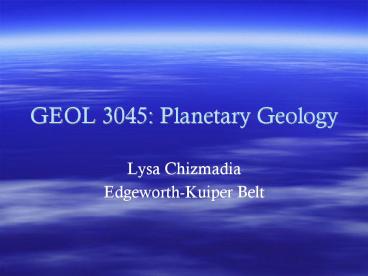GEOL 3045: Planetary Geology - PowerPoint PPT Presentation
1 / 13
Title:
GEOL 3045: Planetary Geology
Description:
Discovered in 1992 by David Jewitt & Jane Luu. Estimated 70,000 objects 100km ... Thick: up to 10 outside ecliptic. More diffuse distribution extends further ... – PowerPoint PPT presentation
Number of Views:63
Avg rating:3.0/5.0
Title: GEOL 3045: Planetary Geology
1
GEOL 3045 Planetary Geology
- Lysa Chizmadia
- Edgeworth-Kuiper Belt
2
Introduction
- Discovered in 1992 by David Jewitt Jane Luu
- Estimated gt70,000 objects gt100km
- Estimated mass 0.06-0.3 x ?
- Source for short-period comets
- Period lt 200 years
HST image
Images from http//www.nineplanets.org/kboc.html
Image fromMalhotra Williams (1997)
3
Structure of the Kuiper Belt
- EKB from 30-55 AU
- Main body from 32 at 39.5Au to 12 at 48AU
- Thick up to 10? outside ecliptic
- More diffuse distribution extends further
Image from http//en.wikipedia.org/wiki/Kuiper_be
lt
4
Kuiper Belt Objects
- NH3, CH4 H2O ices
- Quaoar
- Xline H2O, not amorph
- resurfaced
Images from http//en.wikipedia.org/wiki/Kuiper_b
elt
5
Types of KBOs
- Name is controversial
- AKA Trans-Neptunian Objects (TNOs)
- Includes KBOs but also all other objects orbiting
Sun at the edge of the solar system - Three main groups
- Classical objects
- Resonant objects
- Scattered objects
Images from http//en.wikipedia.org/wiki/Kuiper_b
elt
6
Classical Objects
- AKA cubiwanos (Q-B-1-os)
- 42-47 AU
- No resonances w/ Neptune
- Two populations
- Dynamically cold
- Nearly circular orbits (elt0.1)
- Low inclinations lt10?
- Redder compositions
- Formed in position, may have migrated w/
Neptune - Dynamically hot
- Nearly circular orbits (elt0.1)
- Higher inclinations lt30?
- Thought to have formed near Jupiter the ejected
Image from Jewitt Luu (1995)
7
Resonant Objects
- Locked in mean motion resonances with Neptune
- 23 Pluto Plutinos
- Semi major axis 39.4 AU
- 200 objects
- 12 called twotinos
- Semi major axis 47.7 AU
- Sparesely populated
- Minor resonances
- 34, 35, 47, 25
- gt50 AU Kuiper Cliff
Image from Jewitt et al. (1998)
Image from http//en.wikipedia.org/wiki/Kuiper_be
lt
8
Scattered Objects
- High eccentricities
- 0.59
- High inclinations
- 24
- Origin of Jupiter-family comets
Image from Duncan Levison (1997)
Image from http//en.wikipedia.org/wiki/Kuiper_be
lt
9
Pluto System
- Barycenter between Pluto Charon
- At least 3 moons
- Charon (double object)
- Nix (in same plane as Charon)
- Hydra (16 res w/ Charon)
- Atmosphere
- N2, CH4, CO
- Structure (?1.8-2.1 g/cm3)
- 1) Frozen N2
- 2) H2O ice
- 3) Silicate H2O ice
Image from http//en.wikipedia.org/wiki/Pluto_28
astronomy29
Images from http//en.wikipedia.org/wiki/Charon_(
moon)
10
Pluto As A Planet
- Pro
- Hydrostatic equilibrium (spherical shape)
- Primarily orbits Sun
- Larger than 1000 km
- Largest object in general vicinity (has cleared
its neighborhood)
- Con
- High inclination
- High eccentricity
- Orbits barycenter w/ Charon
- Not largest object in KB (has not cleared its
neighborhood)
Images from http//en.wikipedia.org/wiki/2006_def
inition_of_planet
11
Centaur Comets
- Orbit between Jupiter Neptune
- Orbits not stable
- At least 3 display cometary comas
- Probably from KB
- Reflectance spectra
- Amorphous carbon
- Hydrocarbons
- Methanol ice
Image from Stern Campins (1996)
12
Formation Theories
- The classical resonant KBOs probably not
primordial - Inclinations eccentricities too high
- Three formation theories
- Long-term effects of planetary perturbations
- Resonant sweeping due to planetary migration
- Massive scatterers resulting in impacts
gravitational perturbations - As of 2006, 9 other star systems have KB-like
disks
Images from http//en.wikipedia.org/wiki/Kuiper_b
elt
13
Summary
New Horizons
- From 33-50 AU
- Composed of NH3, CH4 H2O ices
- Quaoar has crystalline H2O ice on surface
- Evidence for resurfacing
- Three types of objects
- Classical
- Resonant
- Scattered
- Centaur comets similar compositions
- Probably originated in KB
- Plutos status as a planet
- Hydrostatic equilibrium
- Primarily orbits sun
- Has cleaned up neighborhood?
Image from http//en.wikipedia.org/wiki/Kuiper_be
lt































